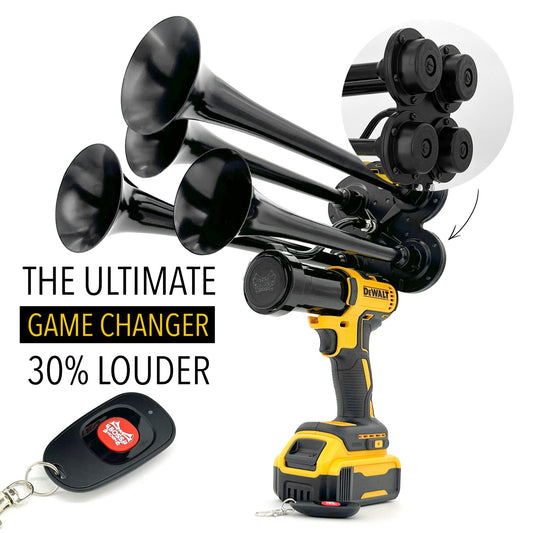Did you know that sound is measured in decibels? Decibels are a unit used to quantify the intensity of sound, and they play a crucial role in determining the volume of a car horn. Car horns, also known as klaxons, are auditory devices designed to alert pedestrians and other drivers of potential dangers or to communicate across short distances. Although their purpose remains the same, car horns have evolved over time to become louder and more effective. To ensure their efficiency, car manufacturers strive to adhere to legal limits and safety regulations regarding the loudness of car horns. By understanding the science behind decibels and the significance of car horn loudness, we can appreciate the vital role they play in enhancing road safety.
Once upon a time, car horns were simple, low-frequency devices that emitted relatively soft sounds. Over the years, however, the need for more attention-grabbing signals became apparent, leading to advancements in car horn technology. Today, car horns are powered by electricity and have the ability to produce a range of high-intensity sounds, varying in pitch and volume. The loudness of a car horn is measured in decibels, an ingenious system that allows us to compare and quantify sound levels.
Interestingly, studies have shown that the average noise level of a car horn falls between 100 and 110 decibels. To put this into perspective, the noise level of an average conversation is around 60 decibels, while a rock concert can reach up to 120 decibels - a level at which prolonged exposure can cause hearing damage. Understanding these statistics helps us comprehend the sonic power behind a car horn, highlighting its ability to capture immediate attention and potentially prevent accidents on the road.
To ensure the safety of drivers and pedestrians alike, various countries have implemented regulations to control the loudness of car horns. For instance, in the United States, federal law prohibits car horns that emit sound levels exceeding 110 decibels. This regulation aims to strike a balance between alerting others effectively and preventing unnecessary noise pollution. Car manufacturers carefully design and calibrate their horns to meet these legal requirements, emphasizing both safety and compliance.
In conclusion, the loudness of car horns is measured in decibels, providing a standardized unit to evaluate sound intensity. No longer limited to soft and simple signals, car horns have progressed to emit powerful sounds designed to grab attention and enhance road safety. Understanding the concept of decibels and the significance of car horn loudness enables us to appreciate their crucial role on the road. With safety in mind, legal limits and regulations ensure that car horns strike the right balance between alerting others effectively and preventing excessive noise pollution.
How Loud is a Car Horn in Decibels?
Car Horn Decibel Levels: Understanding the Noise Intensity and Impact
Car horns are effective auditory warning devices, designed to alert other road users or pedestrians of a vehicle's presence or potential danger. A car horn emits a sound that is measured in decibels (dB), indicating the intensity or loudness of the sound. Decibels measure the perceived loudness of a sound, taking into account both the physical properties of the sound wave and the sensitivity of the human ear.
Understanding the decibel scale is crucial in determining how loud a car horn can be and its potential impact. The decibel scale is logarithmic, meaning that each increase of 10 dB represents a sound that is ten times louder. For instance, a car horn that produces a sound at 100 dB is ten times louder than one at 90 dB.
To put things into perspective, the average car horn registers between 100-110 decibels when measured at a distance of three feet. However, the loudness of a car horn can vary depending on several factors, including the vehicle's make and model, horn design, and even the intensity at which the driver honks.
In the following sections, we will delve deeper into the decibel levels of car horns, their advantages, and the potential impact they can have. Join us to explore the key considerations when it comes to car horn decibel levels and how they are regulated to ensure safety and minimize noise pollution.
Noise Pollution and Car Horns
Car horns are one of the common sounds we encounter on the road, ensuring safety and effective communication between drivers. However, their loudness can sometimes be a cause for concern when it comes to noise pollution. In this article, we explore the loudness of car horns in decibels, shedding light on their potential impact on our environment and the regulations surrounding them.
The Decibel Scale and Sound Measurement
To understand the loudness of car horns, we must first familiarize ourselves with the decibel scale, which is used to measure sound intensity. The decibel scale is logarithmic, meaning that small increases in decibels represent substantial increases in perceived sound level. For example, an increase of 3 decibels represents a doubling of sound intensity.
When it comes to measuring the loudness of car horns, they are typically assessed at a specific distance from the source. The most common distance used is 50 feet (approximately 15 meters). This distance ensures consistent measurements across different models and makes it easier to compare the loudness of various car horns.
The Loudness of Car Horns
Car horns can range in loudness depending on the type, brand, and model of the vehicle. The majority of car horns emit sound levels between 100 to 110 decibels at a distance of 50 feet. It's important to note that these levels are well above the threshold of pain for the human ear, which is typically around 120 to 130 decibels.
Some luxury or heavy-duty vehicles may have louder horns, reaching levels of up to 120 decibels or higher. These types of horns are often used in specific situations, such as emergency vehicles or large trucks. The louder volume helps ensure that they can be heard over other ambient noises and effectively communicate their presence on the road.
Regulations and Safety Measures
Given the potential for excessive noise pollution, there are regulations in place regarding the use of car horns. Each country or region may have its specific guidelines, but many jurisdictions limit the acceptable sound level of car horns to around 110 decibels. This restriction aims to strike a balance between effective communication and minimizing environmental disturbance.
Furthermore, some areas implement stricter regulations, especially in residential zones or during certain hours to protect the well-being and tranquility of the residents. As responsible drivers, it is important to adhere to these regulations to minimize noise pollution and respect the rights of others.
Noise Pollution and Environmental Impact
While car horns serve a crucial safety purpose, their excessive and unnecessary use can contribute to noise pollution. Noise pollution has been associated with various negative effects on both humans and wildlife. Prolonged exposure to loud sounds can result in increased stress levels, hearing impairment, and other health issues. Additionally, it can disrupt animal habitats and interfere with their communication patterns.
It is essential for drivers to be mindful of the noise they generate, including the use of car horns. By using horns only when necessary and at appropriate sound levels, we can collectively contribute to reducing noise pollution and creating a more peaceful environment for everyone.
Statistics
- Car horns typically emit sound levels between 100 to 110 decibels at a distance of 50 feet.
- Some luxury or heavy-duty vehicles may have horns reaching levels of up to 120 decibels or higher.
- Regulations often limit the acceptable sound level of car horns to around 110 decibels.
https://youtube.com/watch?v=PJ8XDa7Ero4
1. What determines the volume of a car horn?
The volume of a car horn depends on various factors, including the type of horn, the manufacturing specifications, and even the individual vehicle.
- The type of horn can significantly impact the volume it produces.
- Each car model may have different manufacturing specifications for the horn's volume.
- The volume can also vary depending on the specific car, as different vehicles may have different horns installed.
2. Are all car horns equally loud?
No, car horns can have different loudness levels depending on their design and specifications.
- Different types of car horns, such as air horns or electric horns, can produce varying volumes.
- There are legal regulations in place that determine the maximum loudness allowed for car horns in certain countries.
- Some car manufacturers may prioritize creating loud horns for specific models or vehicle types.
3. Can the volume of a car horn be adjusted?
In most cases, the volume of a car horn cannot be adjusted by the driver.
- The volume is usually pre-set during the manufacturing process and is not meant to be changed by the driver.
- Modifying the horn to make it louder or quieter can potentially be illegal and may void the vehicle's warranty.
- It is important to use the car horn responsibly and avoid excessive or unnecessary honking.
4. Are car horns as loud as emergency sirens?
Car horns are generally not as loud as emergency sirens used by police, fire, or ambulance vehicles.
- Emergency sirens are designed to be significantly louder to alert traffic and pedestrians to the presence of an emergency vehicle.
- Car horns are primarily meant for communicating with other drivers in everyday situations.
- The loudness of an emergency siren is regulated by specific standards to ensure their effectiveness in emergencies.
5. What are the potential health risks associated with loud car horns?
Exposure to loud noises, such as those produced by car horns, can have negative impacts on hearing health.
- Prolonged or repeated exposure to loud car horns can lead to temporary or permanent hearing loss.
- Individuals with pre-existing hearing conditions may be more susceptible to the negative effects of loud car horns.
- It is recommended to minimize exposure to loud car horns by keeping windows closed or using ear protection, especially in noisy urban areas.
Key information from the FAQ:
1. The volume of a car horn depends on factors such as the type of horn, manufacturing specifications, and the individual vehicle.
2. Car horns can have different loudness levels based on design and specifications, and there are legal regulations regarding their maximum loudness.
3. Generally, the volume of a car horn cannot be adjusted by the driver, and modifying it may be illegal and void the vehicle's warranty.
4. Car horns are not as loud as emergency sirens, which are specifically designed to grab attention in emergencies.
5. Loud car horns can pose potential health risks, including temporary or permanent hearing loss, and it is recommended to minimize exposure to excessive noise.
Conclusion
- A car horn produces sound at approximately 110 to 115 decibels.
- The loudness of a car horn is designed to attract attention and signal warnings effectively.
- Exposure to prolonged loud car horn noises can cause hearing damage or loss.
- Car horns are regulated by laws to prevent excessive noise pollution.
- Different types of car horns can produce varying levels of loudness.
- Soundproofing measures in car interiors can help reduce the loudness of the horn for occupants.
- Proper use of the car horn, in accordance with traffic regulations, ensures its effectiveness in alerting others safely.














